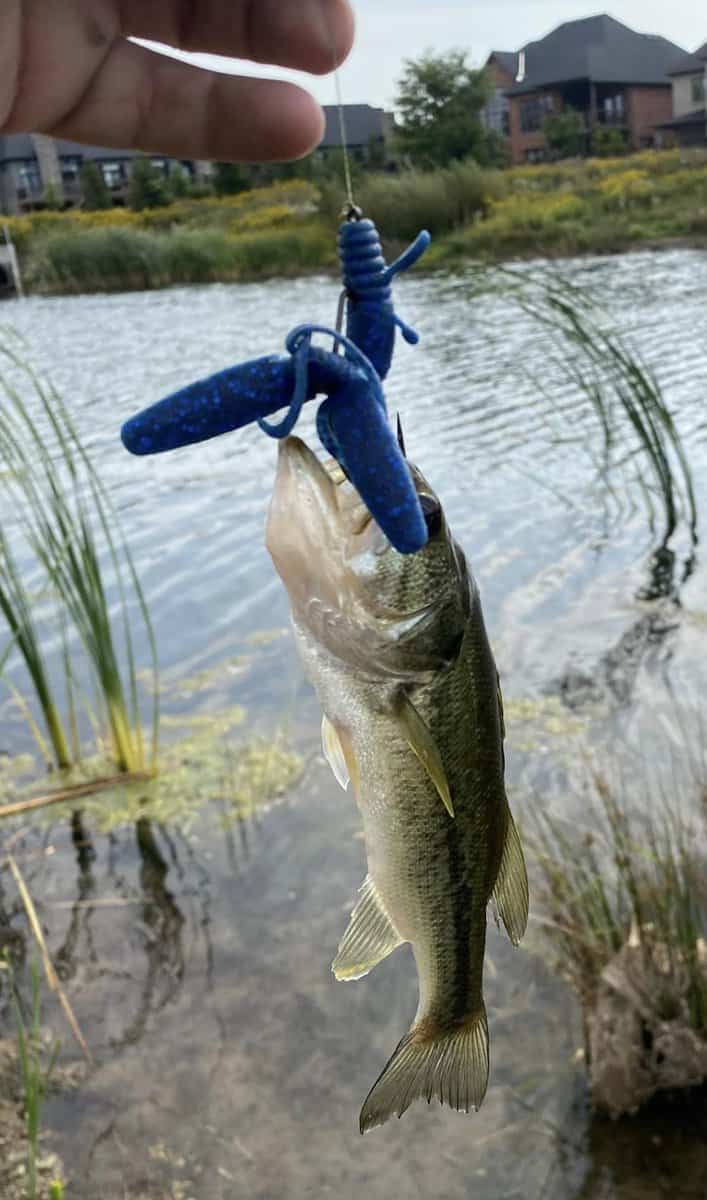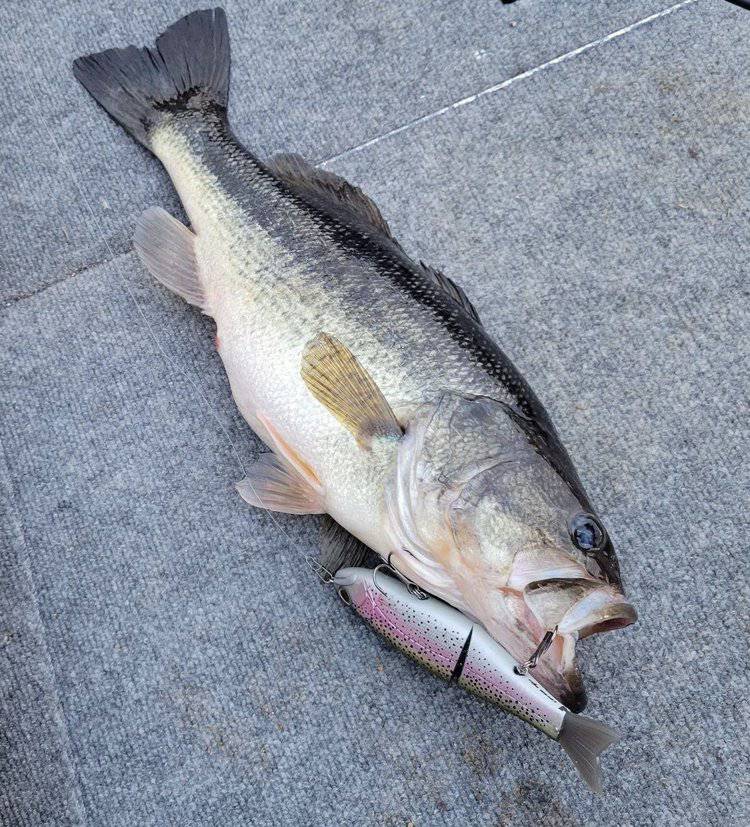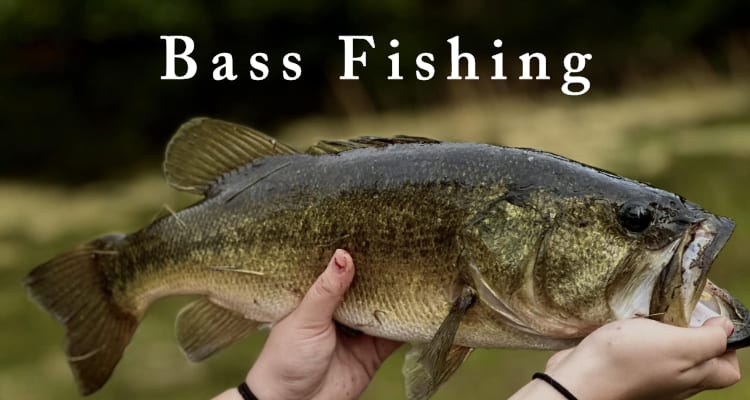Bass, specifically largemouth and smallmouth bass, are among the most sought-after freshwater game fish in North America. They are known for their aggressive strikes and the exciting fight they put up when hooked, making them a favorite target for anglers. This guide will cover the essential aspects of bass fishing, including the best setups, baits, techniques, and times to catch them. Whether you are targeting largemouth or smallmouth bass, the thrill of catching these fish is unparalleled, and with the right knowledge, you can significantly increase your success rate.
Bass Fishing Setup
The most common tackle setup to catch bass includes a medium to medium-heavy rod, a baitcasting or spinning reel, and a line strength of 8 – 20 pounds. A 6 – 7 foot rod is versatile, offering a good balance between casting distance and accuracy, as well as the sensitivity needed to detect bites and the backbone to handle the fight of a large bass.
The best setup for bass fishing involves a combination of a baitcasting reel and a medium-heavy rod for more experienced anglers, as this setup provides greater control and accuracy for casting lures or baits at specific targets. A spinning setup with a medium action rod is excellent for beginners or situations requiring lighter lures and finesse techniques. The choice between using a baitcasting or spinning setup largely depends on personal preference and the fishing technique employed.
When it comes to rigging, Texas Rig is the best and most popular bass rig. It is highly favored for its effectiveness in various conditions, particularly when fishing in heavy cover or vegetation. Texas rig involves a soft plastic bait, like a worm or creature bait, rigged on a hook with a sliding weight above it. The size of the hook and weight can vary, but a 3/0 to 5/0 hook and a 1/8 to 1/4 ounce weight are common choices that offer a good balance for different scenarios. The Texas Rig allows the bait to be presented in a weedless manner, minimizing snags while keeping the presentation appealing to bass hiding in cover.

Best Bait for Bass
Bass are opportunistic predators with a diet that includes a wide variety of prey. They primarily feed on smaller fish like shad, minnows, and perch, as well as crustaceans, frogs, insects, and even smaller aquatic animals. Their feeding habits make them susceptible to a broad range of live baits and artificial lures, allowing anglers to employ various strategies to catch them.
The best live bait for bass includes minnows and nightcrawlers, both of which mimic the natural prey of bass. Minnows are particularly effective for largemouth and smallmouth bass, as they closely resemble the fish bass commonly prey upon. Fishing with live minnows can be done using a simple hook and split shot setup or under a bobber to keep the bait at a specific depth. Nightcrawlers, used with a Texas Rig or on a hook under a bobber, can also entice bass, especially in areas where they are accustomed to feeding on earthworms.
When it comes to artificial baits, the best lures for bass include:
- Plastic Worms. These are incredibly effective, especially when rigged Texas style for weedless presentation. The slow, lifelike wiggle of a plastic worm as it’s retrieved can prove irresistible to bass, particularly in warmer waters.
- Crankbaits. These mimic the look and movement of baitfish and can cover a lot of water quickly. Crankbaits are ideal for exploring different depths and locating active bass.
- Glide Baits. A glide bait is a type of swimbait that is designed to move through the water with a smooth, side-to-side motion. They can be very effective because the side-to-side action can trigger strikes from bass by resembling the movements of injured or slowly swimming prey fish, which seem like an easy meal.
- Spinnerbaits. With their flashy blades, spinnerbaits create vibration and visual appeal in the water, attracting bass through both sight and sound. They’re particularly effective in murky water or during low light conditions.
- Topwater Lures. For an exhilarating bass fishing experience, topwater lures are unmatched. They provoke aggressive strikes as bass leap out of the water to catch the lure. Early morning or late evening, when bass are feeding near the surface, is the best time to use them.

Bass Fishing Techniques
Bass fishing offers a range of techniques that cater to different water conditions, times of day, and bass behavior. Here are some of the most common and effective techniques used to catch bass, along with their setups and ideal conditions.
Casting and Retrieving
This technique involves casting a lure out and then retrieving it in a manner that mimics the prey bass eat, such as small fish or insects. Use a medium-action rod with a spinning or baitcasting reel loaded with 8 – 12 lb test line. The key is to vary the speed and pattern of your retrieve — sometimes fast, sometimes slow, with occasional pauses or twitches — to trigger a strike. It’s effective in open water or along the edges of weed beds and structures where bass hunt for food.
Texas Rigging
The Texas Rig is perfect for fishing in heavy cover without getting snagged. Use a soft plastic bait, like a worm or creature bait, with a bullet weight placed above the hook on the line. The weight can be adjusted based on depth and the amount of vegetation. This rig is most effective in dense cover or when bass are holding tight to structure. It allows for precise presentations in places where bass might be hiding, such as submerged logs, weed beds, or rocky outcrops.
Drop Shotting
Drop shotting involves a weight tied at the end of the line with a hook attached above it, allowing the bait to suspend off the bottom. Use a light to medium-action spinning rod with 6-10 lb test fluorocarbon line for better sensitivity and less visibility. This technique is particularly effective in deep water or when bass are suspended and less active. It allows for precise control over the presentation, making it ideal for targeting finicky bass with a subtle approach.
Jig Fishing
Jig fishing uses a weighted head and a soft plastic or skirt to mimic crawfish or other bottom-dwelling creatures. Opt for a medium-heavy rod with a baitcasting reel and 12-20 lb test line, depending on cover thickness. Jigs are effective year-round but excel in colder water when bass are deeper and more lethargic. They work well around structures like docks, drop-offs, and rocky bottoms, where a slow, methodical presentation can entice a strike from bass waiting in ambush.
Topwater Fishing
Topwater fishing involves lures that float and create disturbance on the water’s surface, mimicking injured fish or insects. Use a medium-action rod with a fast-retrieve reel and 10-15 lb test line for the best control. This technique is most effective in the early morning or late evening when bass are actively feeding on the surface. It’s thrilling, as it can provoke explosive strikes, and works well over shallow cover, along weed lines, and near structures like logs or docks.
Trolling
Trolling is a technique where you drag one or more fishing lines behind a moving boat, using the boat’s motion to give life to the bait or lure. This method can cover a lot of water and is particularly effective in locating actively feeding bass.
Trolling works well with a variety of lures, including deep-diving crankbaits, swimbaits, and spinnerbaits, depending on the depth at which bass are located. The key is to adjust the speed of the boat to match the desired action of the lure and the activity level of the fish. Slow speeds are typically better for cold water conditions when bass are lethargic, while faster speeds can trigger strikes in warmer water when bass are more aggressive.
Best Time to Catch Bass
Catching bass efficiently requires understanding their behavior throughout the year and at different times of the day. Below is a concise overview of the best times to catch bass
- When do bass spawn? Bass spawn in the spring when water temperatures reach about 55-65°F.
- Best time of day to catch bass: Early morning and late afternoon are prime times because bass are more active and feeding during these cooler parts of the day.
- Best time of year to catch bass: Spring and fall are the best seasons because bass are in shallow waters and more aggressive in preparation for spawning in spring and feeding up for winter in fall.
Spring
In spring, bass move to shallow areas to spawn, making them more accessible. The best time to catch bass is in the late morning and early afternoon as the water warms up. This is when bass become more active and are likely to go after lures and baits. Techniques like Texas Rigging with soft plastics or using spinnerbaits around spawning beds can be particularly effective.
Summer
During the hot summer months, bass often retreat to deeper, cooler waters during the midday sun. Early morning and late evening are the best times to target bass as they come into shallower waters to feed. Topwater lures in the morning or jigs and deep-diving crankbaits during the day near drop-offs and submerged structures work well.
Fall
Fall brings cooler temperatures, and bass will be feeding aggressively to prepare for winter. This makes daytime, especially mid-morning to late afternoon, an excellent time for bass fishing. Bass are more likely to be found in shallow waters again, making spinnerbaits, crankbaits, and topwater lures effective for enticing strikes.
Winter
Winter can slow bass metabolism, but they still need to eat. The best time is during the warmest part of the day, usually midday to early afternoon when the sun has warmed the water slightly. Slow-moving lures like jigs or soft plastics worked very slowly near the bottom can be successful as bass will not expend much energy to chase prey.
Night
Catching bass at night can be surprisingly productive, especially in the summer when water temperatures are cooler. Bass are less wary and more likely to strike at lures and baits. Dark-colored spinnerbaits, topwater lures, or slow-moving plastics are effective. The key is to use lures that make noise or create vibrations to attract bass through their lateral line in the dark.
Where to find Bass
Finding bass involves understanding the types of water bodies they inhabit and how to effectively fish those areas.
Where to find Bass? Lakes, rivers, and ponds are prime habitats for bass, offering ample food and cover.
How deep to fish for bass? Depth varies with seasons; bass can be found in shallower waters (1-10 feet) in spring and fall for spawning and feeding, and deeper waters (10-20 feet or more) in summer and winter.
Utilizing a fish finder can greatly enhance your ability to locate bass, especially in deeper waters, by identifying underwater structures, depth changes, and even the fish directly.
Lakes
Lakes offer diverse habitats for bass, including shallow flats for spawning, deep offshore structures, and everything in between. In lakes, focus on areas with plenty of cover such as weed beds, submerged structures, and drop-offs.
Bass fishing setup for lakes includes a medium-heavy rod with a baitcasting reel and 10-20 lb test line, depending on the cover’s density. Spinnerbaits and plastic worms are effective in these environments, with spinnerbaits working well around submerged vegetation and plastic worms being ideal for slower, more precise presentations near structures.
Rivers
Rivers provide dynamic environments for bass, where they can be found in eddies, behind boulders, and along riverbanks with overhanging trees. The current can play a significant role in where bass decide to hold. In rivers, a medium-action spinning setup with 8-12 lb test line offers the versatility needed to cast a variety of lures. Small crankbaits, spinnerbaits, and soft plastics rigged weedless are effective for navigating the diverse structure and varying currents found in river systems.
Ponds
Ponds, though smaller, can be incredibly productive for bass fishing, especially in areas with less fishing pressure. Bass in ponds often relate to available structure like dock pilings, fallen trees, and weed edges. A light to medium spinning setup with 6-10 lb test line is suitable for the smaller scale of ponds. Topwater lures early in the morning or late in the day, and Texas-rigged soft plastics or jigs during the day, can be very effective in enticing pond bass.
Shore Fishing
Shore fishing for bass is common and can be very rewarding, especially in areas where access to boats is limited. Focus on accessible structures like docks, weed lines, and any visible cover where bass may be lurking. A medium-action rod and spinning reel combo with 8-12 lb test line can handle most shore fishing situations. Using weedless setups like the Texas-rigged soft plastics or weedless spoons can help avoid snags and effectively target bass from the shore.
Tips to Catch Bass for Beginners
- Start with a simple spinning rod and reel combo, around 6-7 feet in length with medium power and fast action, suitable for casting a variety of lures and baits.
- Use monofilament line with a test strength of 8-10 pounds, which is forgiving for beginners and versatile for different bass fishing techniques.
- The best beginner bait is soft plastic worms or creature baits, as they can be used in nearly any water condition and are highly effective for bass.
- For an easy and versatile rig, set up a Texas Rig: thread the soft plastic onto a worm hook, ensuring the bait is straight to avoid spinning and achieve a natural presentation.
- Insert the hook point into the top of the bait, push it through about a quarter inch, and bring it out. Slide the bait up to the eye of the hook, then insert the hook point back into the body of the bait to make it weedless.
- Start with casting near visible structures like logs, rocks, and vegetation edges, as bass often hide in these areas to ambush prey.
- Practice casting accuracy and gently presenting the bait to avoid spooking fish, working the bait back with slow, steady retrieves or intermittent twitches to mimic live prey.
- Pay attention to the water conditions and time of day; early morning and late afternoon are typically the best times to catch bass due to their increased activity.
- Be patient and don’t get discouraged by missed bites or lost fish; bass fishing requires practice and learning from each outing to improve your skills.
- Enjoy the learning process and spend time on the water to observe bass behavior, experimenting with different baits and techniques to find what works best in your local fishing spots.
Best Bass Fishing Gear and Tools
Here’s a guide to the best bass fishing gear and tools, including fishing rod, fishing line, fishing reel, and fish finder.
Fishing Rod
When it comes to bass fishing rods, versatility is key. A medium to medium-heavy power rod with a fast action is generally recommended for bass fishing. This type of rod allows you to cast a variety of lures and effectively set the hook when a bass strikes. Lengths typically range from 6.5 to 7.5 feet, providing a good balance of casting distance and accuracy. Look for rods made from graphite or composite materials for their sensitivity and lightweight design. Popular bass fishing rod brands include G. Loomis, St. Croix, and Abu Garcia.
Fishing Line
The choice of fishing line for bass fishing often depends on the fishing conditions and the techniques you plan to use. Monofilament, fluorocarbon, and braided lines are all suitable options. Monofilament lines are forgiving and stretchy, making them a good choice for beginners and topwater fishing. Fluorocarbon lines have low visibility underwater, making them ideal for clear water situations and techniques like jig fishing or drop-shotting. Braided lines offer excellent strength and sensitivity, making them suitable for heavy cover situations or fishing with topwater frogs. Choose line strengths ranging from 10 to 20-pound test depending on the size of bass you’re targeting and the structure you’re fishing around.
Fishing Reel
For bass fishing, baitcasting reels and spinning reels are both commonly used, depending on personal preference and the techniques being employed. Baitcasting reels offer greater casting accuracy and control, making them popular for techniques like flipping, pitching, and casting heavy lures. Look for a baitcasting reel with a smooth drag system and a high gear ratio for quick retrieves. Spinning reels are preferred for finesse techniques like drop-shotting, shaky head fishing, and light line applications. Choose a spinning reel with a smooth drag system and a lightweight, durable construction. Reels from reputable brands like Shimano, Daiwa, and Abu Garcia are widely used and trusted by bass anglers.
Fish Finder
A fish finder can be a valuable tool for locating bass and identifying underwater structure and cover. Choose a fish finder for bass with CHIRP sonar and side imaging capabilities for the best results. CHIRP sonar provides clearer images of fish and underwater structures, while side imaging allows you to scan a larger area and locate fish-holding structure like submerged trees, rock piles, and drop-offs. Brands like Lowrance, Humminbird, and Garmin offer a range of fish finders suitable for bass fishing, with options to fit different budgets and preferences.

